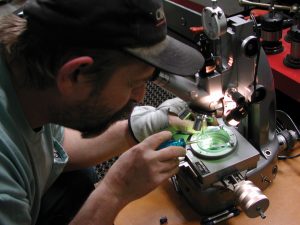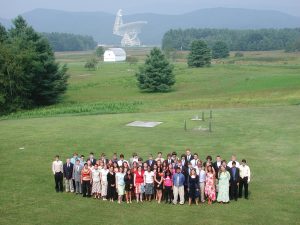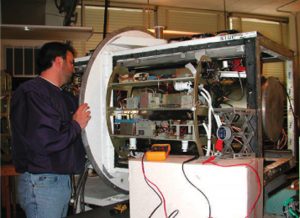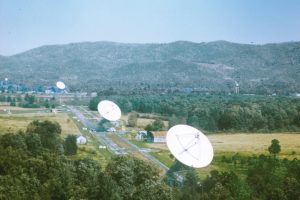Dwayne Barker is using a microscope to inspect and make measurements on a part. The microscope has a grid inside that can be used to measure the size of features on even our smallest machined components.


Governor’s School
The National Youth Science Foundation and the National Radio Astronomy Observatory collaborate to run the West Virginia Governor’s School for Mathematics and Science at the NRAO in Green Bank, West Virginia. Students stay in the dormitories and use the 40-foot telescope as well as do microbiology and botany field work experiments in the nearby forests.

High Tech Tour in Green Bank
Green Bank hosts High Tech Tours to give visitors a truly behind-the-scenes look at the incredible custom-made electronics and engineering that goes into our many telescopes.

The GBI in 1968
The 85-3 and the 85-2 twin 85-foot telescopes working together with the 85-1 (not shown) in the Green Bank Interferometer, the NRAO’s first array. The GBI operated from 1967-2006. From 1978-1996, it was operated in support of USNO and NRL geodetic and astronomy programs; after 1996 in support of NASA High Energy Astrophysics programs. In the background of this photo, the 300-foot telescope ghosts through the trees.

Twin Telescopes
The 85-3 and the 85-2 twin 85-foot telescopes working together with the 85-1 (not shown) in the Green Bank Interferometer, the NRAO’s first array. The GBI operated from 1967-2006. From 1978-1996, it was operated in support of USNO and NRL geodetic and astronomy programs; after 1996 in support of NASA High Energy Astrophysics programs.

Green Bank Interferometer
All three 85-foot telescopes of the roughly east-west arm of the Green Bank Interferometer, the NRAO’s first array. A fourth member of the GBI would have been in operation about 13 miles away. The GBI operated from 1967-2006. From 1978-1996, it was operated in support of USNO and NRL geodetic and astronomy programs; after 1996 in support of NASA High Energy Astrophysics programs.





